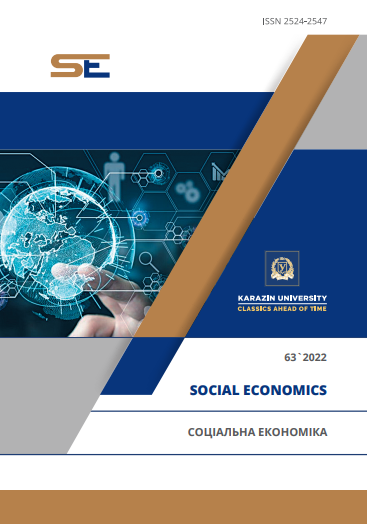UKRAINE WITHIN THE WORLD TRENDS OF THE HIGH-TECH PRODUCTS EXPORT MARKET
Abstract
Abstract. The article is devoted to the research of world tendencies of the market of export of high - tech products and definition of features of dynamics and place in it of Ukraine. This study notes that the ability to generate and implement its own innovations and produce and improve high-tech goods and services will ensure strong competitiveness of the country, its financial stability and determine its place in the global economic environment of the future.
The study based on the author's methodology "analysis of speed and acceleration", which involves the calculation and economic feasibility of these indicators and allows you to assess the country's potential to change trends.
I analyzed the structure of exports of high-tech products in the world by countries and the dynamics of its volume by leading countries and Ukraine. I built rankings of countries on the absolute value of the rate of change in high-tech exports. I was studied the dynamics of speed and acceleration of changes in the volume of exports of high-tech products by country and grouped according to the ratio between these indicators.
I determined that one of the important reasons for Ukraine's insignificant place in the world market of high-tech products is the state policy in the field of science, technology and industry, which has been implemented in the country for the past 30 years; reducing the role of science in the economy by transferring it from the determining factor of production ("vector of development") to the "vector of pride".
I showed that Ukraine's stay in the 2nd group in 2019-2020 indicates the potential to change the situation, as the impact of factors affecting high-tech exports is positive, but still insufficient for the country's transition to accelerated growth. I believe that providing conditions at the state level for investment in high-tech industries of the country will contribute to this growth.
Downloads
References
Dobrov, G. M. (1987). Scientific and technical potential: Structure, dynamics, efficiency (Naukova Dumka). (in Russian)
Salikhova, O. B. (2012). High-Technological Variations: Type of Methodology of Evaluation before the Date in Ukraine: Monograph. Institute of Economics and Forecasting of the National Academy of Sciences of Ukraine. Kyiv. (in Ukrainian)
Prushkivska, E. V., & Buyukyan, A. R. (2019). Features of development of high-tech export of Ukrainian enterprises. Economic Bulletin of the National Mining University, 67, 9–15. doi: https://doi.org/10.33271/ev/67.009.
Matyushenko, I., Trofimchenko, K., Ryeznikov, V., Prokopenko, O., Hlibko, S., & Krykhtina, Y. (2021). Innovation and investment mechanism for the formation and implementation of state policy to ensure the technological competitiveness of leading countries and Ukraine in the digital economy. Linguistics and Culture Review, 5(S4), 1508–1551. doi: https://doi.org/10.21744/lingcure.v5nS3.1880.
Porter, M. (1990). Competitive Advantage of Nations. Competitive Intelligence Review, 1(1), 14–14. doi: https://doi.org/10.1002/cir.3880010112.
Hatzichronoglou, T. (1997). Revision of the High-Technology Sector and Product Classification. OECD. doi: https://doi.org/10.1787/134337307632.
Ross, A. (2017). The Industries of the Future (Reprint edition). Simon & Schuster.
Haltiwanger, J., Hathaway, I., & Miranda, J. (2014). Declining Business Dynamism in the U.S. High-Technology Sector (SSRN Scholarly Paper ID 2397310). Social Science Research Network. doi: https://doi.org/10.2139/ssrn.2397310.
Yang, B., & Zhu, S. (2021). Public funds in high-tech industries: A blessing or a curse. Socio-Economic Planning Sciences, 101037. doi: https://doi.org/10.1016/j.seps.2021.101037.
Özsoy, S., Ergüzel, O. Ş., Ersoy, A. Y., & Saygılı, M. (2022). The impact of digitalization on export of high technology products: A panel data approach*. The Journal of International Trade & Economic Development, 31(2), 277–298. doi: https://doi.org/10.1080/09638199.2021.1965645.
Srholec, M. (2007). High-Tech Exports from Developing Countries: A Symptom of Technology Spurts or Statistical Illusion? Review of World Economics (Weltwirtschaftliches Archiv), 143, 227–255. doi: https://doi.org/10.1007/s10290-007-0106-z.
Kabaklarli, E., Duran, M. S., & Üçler, Y. T. (2018). High-technology exports and economic growth: Panel data analysis for selected OECD countriesHigh-technology exports and economic growth: panel data analysis for selected OECD countries. Forum Scientiae Oeconomia, 6 (2): Economic Growth, Innovations and Lobbying, 47–60. doi: https://doi.org/10.23762/FSO_VOL6NO2_18_4.
Şahi̇n, L., & Şahi̇n, D. K. (2021). The Relationship Between High-Tech Export and Economic Growth: A Panel Data Approach for Selected Countries. Gaziantep University Journal of Social Sciences, 20(1), 22–31. doi: https://doi.org/10.21547/jss.719642.
Ersin, Ö., Ustabaş, A., & Acar, T. (2022). The nonlinear effects of high technology exports, R&D and patents on economic growth: a panel threshold approach to 35 OECD countries. Romanian Journal of Economic Forecasting, 25, 26–44.
Rivlin, P. (Ed.). (2010). Globalization and High Technology. В The Israeli Economy from the Foundation of the State through the 21st Century (сс. 94–117). Cambridge University Press. doi: https://doi.org/10.1017/CBO9780511921308.007.
Marukawa, T. (2013). Japan’s High-Technology Trade with China and Its Export Control. Journal of East Asian Studies, 13(3), 483–501. doi: https://doi.org/10.1017/S1598240800008316.
Ustabaş, A., & Ersin, Ö. (2016). The Effects of R&D and High Technology Exports on Economic Growth: A Comparative Cointegration Analysis for Turkey and South Korea. 44–55. doi: https://doi.org/10.36880/C07.01475.
Ege, A., & Ege, A. Y. (2017). The Turkish economy and the challenge of technology: A trade perspective. New Perspectives on Turkey, 57, 31–60. doi: https://doi.org/10.1017/npt.2017.28.
Garces, E. J., & Adriatico, C. G. (2019). Correlates of High Technology Exports Performance in the Philippines. Open Journal of Social Sciences, 7(5), 215–226. doi: https://doi.org/10.4236/jss.2019.75018.
Siddiqui, A. A. (2022). Technology Intensive Exports and Growth of Asian Economies. The Indian Economic Journal, 00194662221082205. doi: https://doi.org/10.1177/00194662221082205.
Bielov, O. (2019). Human resources as an integral part of Ukraine’s scientific and technical capacity: Features of dynamics. Herald of Economics, 2, 24–35. doi: https://doi.org/10.35774/visnyk2019.02.024.
OECD Taxonomy of Economic Activities Based on R&D Intensity (OECD Science, Technology and Industry Working Papers Вып. 2016/04; OECD Science, Technology and Industry Working Papers, Т. 2016/04). (2016). doi: https://doi.org/10.1787/5jlv73sqqp8r-en.




